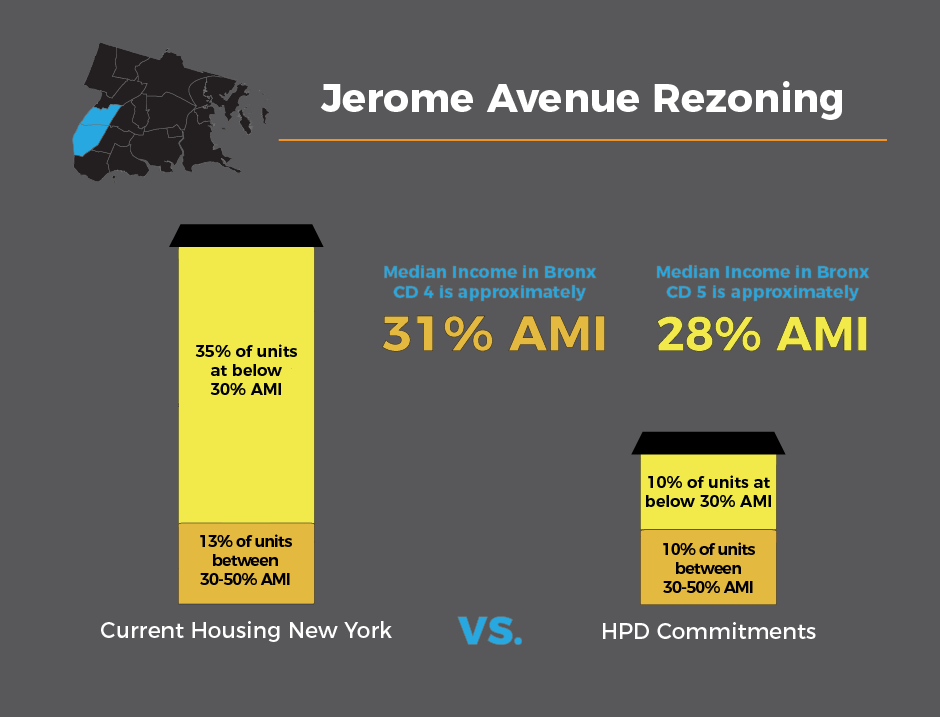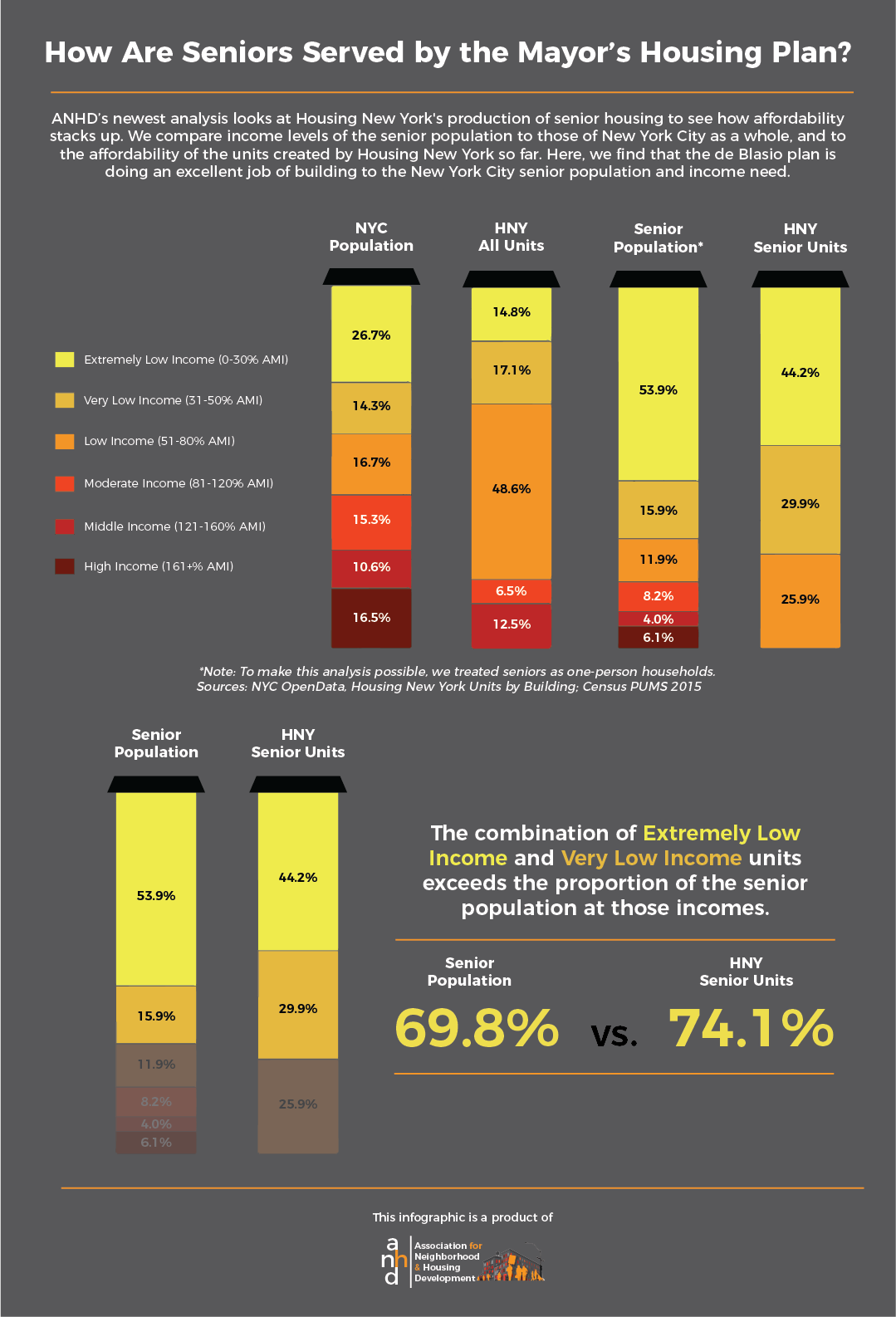Community Demands Scope of Jerome Rezoning Be Reduced, As City Moves Proposal Forward
On Wednesday morning the City Planning Commission (CPC) voted to approve the proposed rezoning of Jerome Avenue in the Bronx. As the Association for Neighborhood & Housing Development (ANHD) has highlighted throughout this process, this rezoning continues to move forward despite consistent and clear demands from the community that the City reconsider and adjust. Yet with CPC approval of the rezoning, only a final vote by the City Council remains to determine its fate. The Bronx Coalition for a Community Vision is urging the Council to reduce the scale of the Jerome Avenue rezoning by half – from roughly 4,000 to 2,000 projected units. Coalition members were at the CPC vote on Wednesday to express their disapproval and make their voices heard. Here’s why they’re concerned and why they’re pushing for the rezoning to be reduced.
The crux of the Coalition’s argument is this: the scale of the proposed rezoning will make it more difficult to construct and preserve truly affordable housing in the neighborhoods around Jerome Avenue. Currently the City is doing a good job of subsidizing affordable housing in Community Districts 4 and 5 in the Bronx – and at much deeper affordability levels than it’s achieving city-wide. Of the 1,580 affordable units created in the CDs through Housing New York between 2014 and the first half of 2017, 35% of them were set aside for Extremely Low Income (ELI) households making up to 30% of Area Median Income (AMI), or about $25,000 for a family of three. In Jerome, the Mayor’s Housing plan currently produces a significantly higher percentage of ELI units than the citywide benchmark of just 15% ELI; the proposed rezoning threatens to put the production of these deeply affordable units – ones that actually come close to matching the needs of the community where half of households make under $25,000 a year – at risk.
The City cannot produce affordable housing using subsidy – as they are doing to good effect today – unless developers choose to partner with them. One consequence of the scale of the proposed rezoning would be to make this less likely. DCP’s Jerome Avenue proposal represents a marked change in land use, opening up the possibility of a massive amount of new residential housing where it’s currently not allowed. This type of wholesale changing of land use has the potential to significantly increase land value for private developers, and with it the housing market around Jerome Avenue. As it does, this will change the calculus for developers; rather than taking subsidy in exchange for affordability many will decide they are better off building market-rate. Yes, many of these market-rate developments will have to include affordable units set aside through Mandatory Inclusionary Housing (MIH), but as we’ve detailed before, these units will be out of reach for a majority of the community. Neighborhood residents understand this and this is why they’re pushing back. Their message to the City is: Don’t trade the deeply affordable units you’re subsidizing right now for the possibility of a gentrifying housing market where the only guaranteed affordable housing would be out of our reach.
There are indications that the City understands this is a risk. As part of the rezoning, HPD has made a commitment to guarantee certain affordability levels in all HPD-financed new construction: with at least 10% of units for families earning less than 30% AMI, and an additional 10% for families earning between 30 – 50% AMI. But these committed numbers are in fact significantly lower than what is currently being created in the community. Currently, 35% of new affordable units in Community Districts 4 and 5 are going to households making below 30% AMI; the City’s commitment would provide less than 1/3 of that amount. This tradeoff makes no sense to the community.
This is why the Bronx Coalition for a Community Vision is calling for reducing the scale of the Jerome Avenue rezoning by shrinking the boundaries, lowering the zoning designations or some combination of the two. The community understands that the smaller the influx of new market-rate housing, the greater the possibility of constructing and preserving truly affordable housing. If the rezoning is reduced by half, there is a better chance that the market won’t undergo a drastic change and that what gets built will get built with subsidy; the City, furthermore, can dedicate their financial resources to ensuring these subsidized developments happen faster.
The City makes a larger argument about the need for the Jerome Avenue rezoning, reasoning that we need to increase the overall supply of housing of any type in order to meet the rising citywide demand and citywide affordability crisis at almost all rent levels, so the bigger the rezoning, the better. But where the City choses to site the major neighborhood rezonings matters; there is an opportunity to generate significant new private production in neighborhoods where housing markets have been relatively weak, such as Jerome Avenue, but those are also the exact neighborhoods that are most vulnerable to secondary displacement pressures when a significant amount of new market-rate housing is built. The amount of new private, market-rate housing that is incentivized by a rezoning must be very carefully balanced with the number of new affordable units that are created, and the depth of that affordability. If the balance isn’t right, then the net impact on the community will be to undermine actual neighborhood affordability. The Coalition knows that neighborhoods like those around Bronx’s Jerome Avenue are among the dwindling number of actually affordable neighborhoods in the City, and they have seen the inevitable worsening of gentrification of far too many neighborhoods where CPC and the City got it wrong.
As the rezoning moves to the next and final step of the process, the City Council should listen to the Coalition’s arguments and respond to their demands to reduce the scale of the rezoning. As Coalition member Roman Sigilfredo put it, if the City had “listened to us better, they would have a better understanding of our neighborhood and understand what it means to make the right decision.” It’s not too late. There is still time to listen and get it right.
Christopher Walters, ANHD’s Rezoning Technical Assistance Coordinator
 ANHD 2016 Building the Community Development Movement
ANHD 2016 Building the Community Development Movement





